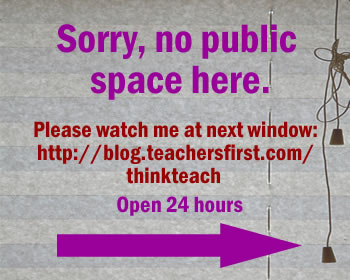Last Friday I spent the day at a conference in Princeton on Children and Electronic Media: Teaching in the Technological Age. There were presentations on current research concerning the impact of electronic media on children and youth, innovative uses of technology in classrooms, and professional development using electronic media (synchronous and asynchronous). The presenters were all recognized voices; many in the auditorium were also recognized “eyes and ears,” as well as practitioners. Kevin Jarrett, one of the presenters and “Mr. Second Life” of education [my nickname], blogged the event today, and his reverence for the minds in the room is quite appropriate. It was an energizing gathering — one that seems destined to echo in orange.
I spent a good part of the weekend letting the conference incubate in my head. The issues of implementing teacher professional development in rigorous, differentiated, yet supportive and respectful formats are so critical to the future success of our students, and there is simply SO much for so many to learn, and never “be done.” The ProfDev concerns I have been mulling:
1. Time. How can we streamline the start-up and personalization of PD in a one-size-fits-all mindset? So many administrations simply want “all staff” to “complete” this or that Prof Dev “training,” whether it is on special ed procedures, a new language arts program, or –oh yeah– we have to do the technology stuff (Why so many do technology “training” in isolation is a major issue, as well!)
2. Respect and expect. How do we shift to a model that allows differentiation hand in hand with rigor: respect where teachers say they are (“I need to learn more about teaching xxx in a project-based approach but am also nervous about doing anything with technology”) yet expect them to step outside of their comfort zones with respectful support and encouragement. Without both, you waste your money and their time. With both, change can actually happen.
3. Hanging together. In a standard, hierarchical arrangement of admin and teachers, there may well be administrators placed in the position of evaluating and approving personalized Prof Dev plans who know the topics no better than the novice participants. Shouldn’t they simply do it together as part of the cohort, just as we would like students and teacher to be able to work together as learners? What better way to model a new way of “building learners”?
4. Real life. Different teachers have varying degrees of “free” time. There are stages of life when doing anything after 4 or 5 pm is extremely difficult for a teacher: infant at home, aging or dying parents, carpools and coaching for their own kids, moonlighting jobs to pay kids’ tuition, and innumerable other pressures spread and stress so many teachers. This is where the asynchronous options actually make a difference, assuming the 3 concerns above have been resolved wisely. Kevin says
Who has time for PD? We all do. It’s a matter of deciding what’s important. When you’re personally vested in the process, somehow, it gets done!
It’s the “personally vested” part that is tough to achieve in stressed people. We need to respect the limits of real life and expect progress without expecting the same level of expertise from all in the same time frame (NTLB?). If life’s pressures are unreasonable, teachers will never be “vested.” Humans protect their own survival by fighting.
5. Making it meaningful. We are supposed to do this with our students and should expect that our own learning should be the same way. It is our own responsibility to be sure that our OWN prof dev is meaningful. If it isn’t, speak up and ask if you can adjust it (respectfully of course).
6. Vastness. We will never be “done.” We can’t even stay even. We can sift, sort, listen, and ask questions. David Brooks wrote Saturday about The Cognitive Age:
The central process driving this is not globalization. It’s the skills revolution. We’re moving into a more demanding cognitive age. In order to thrive, people are compelled to become better at absorbing, processing and combining information. [my italics]
Teachers need to not only do this absorbing, processing, and combining and with their own skills; they must do it well enough to teach it to tomorrow’s adults. The vastness of this task is huge.
Bright orange is the color of fire, of lively energy and hope, and of sunsets. I hope the fire from this conference will burn brightly as we who were there light some flames in others, and avoid sunset.

 Some people pack bags or arrange for a kennel. I am fortunate enough to be preparing a presentation. See
Some people pack bags or arrange for a kennel. I am fortunate enough to be preparing a presentation. See 



